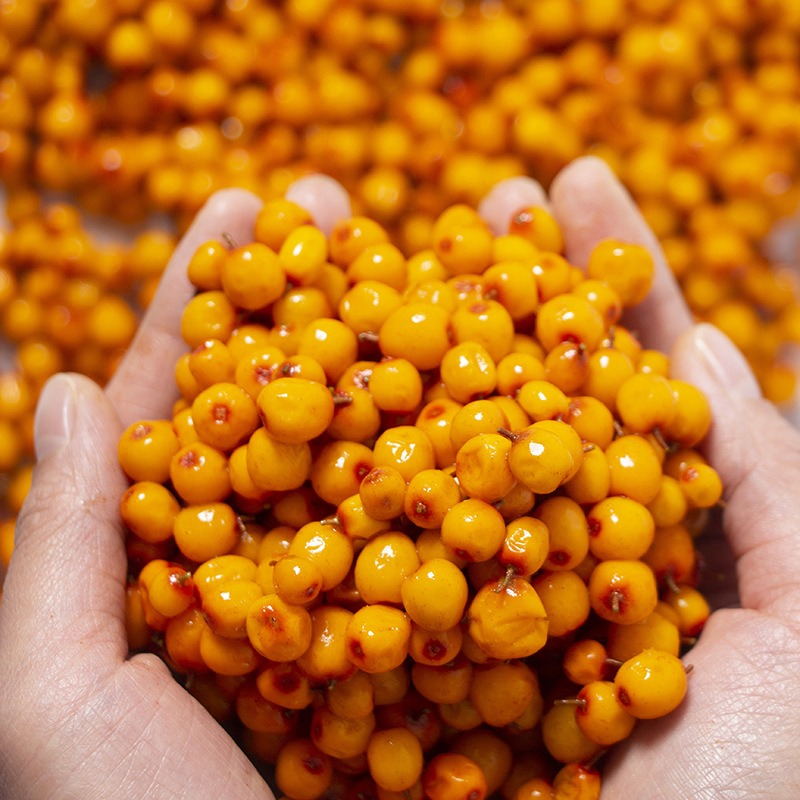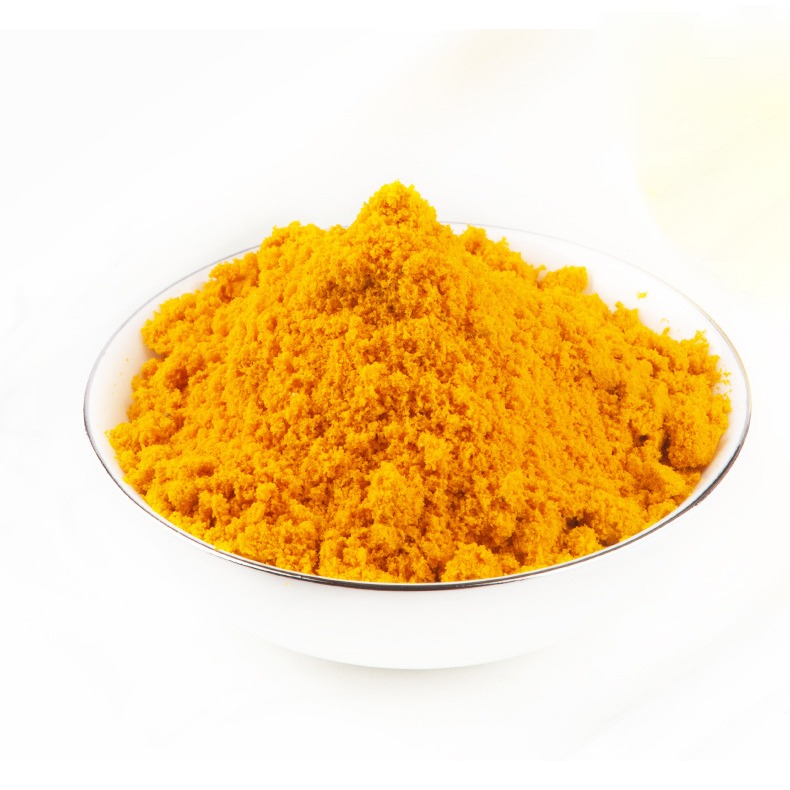Seabuckthorn is a natural medicinal and edible plant with strong vitality. Due to the long-term harsh and changeable ecological changes, the active ingredients in seabuckthorn fruit have reached more than 200 kinds.
Seabuckthorn fruit contains wealthy active nutrients, which allows it to fight health risks.
Today, let’s analyze in detail what active nutrients are in seabuckthorn fruit and what magical effects they have.
Oligosaccharides
Seabuckthorn contains more than 20 kinds, mainly deoxyribose, rhamnose, 4-phosphate erythrose, 7-phosphate sedoheptulose; D-galactose, D-xylose, L-arabinose, L-rhamnose, D-glucuronic acid and D-galacturonic acid, glycosides, etc.
Polysaccharides:
Polysaccharides include cellulose, hemicellulose, pectin, gum arabic, etc.
Functions: weight loss, prevention and treatment of diabetes, scavenging free radicals, anti-oxidation, enhancing immune function, antibacterial, lowering blood sugar, lowering blood lipids, protecting the liver, anti-aging, anti-inflammatory, anti-viral, anti-radiation, anti-tumor, etc.
Polysaccharides can inhibit the growth of cancer cells, affect the cycle of cancer cells, affect the synthesis of cancer cell proteins and nucleic acids, and induce cancer cell apoptosis. It can treat malignant pleural effusions and has the advantages of low toxicity, high safety, and good tumor inhibition effect on radiotherapy and chemotherapy for lung cancer, gastric cancer, liver cancer, cervical cancer, ovarian cancer, and bladder cancer.
Fat:
It includes saturated fat, unsaturated fat, lipids – phospholipids, lecithin, cephalin, inositol phospholipids, terpenes and steroids, cholesterol, ergoinol, cortisol, bile acid, vitamin D, androgen, estrogen, progesterone, etc.
Function: energy source for organisms; maintain body temperature, protect internal organs, buffer external pressure; provide a fatty acid source. Components of cell membranes and nerve tissues, related to the prevention and treatment of diabetes.
Fatty acids:
It’s a type of long-chain carboxylic acid. They can be divided into saturated (no double bonds) or unsaturated (with double bonds).
Functions: energy source for organisms, a component of cell membranes (60-70%), regulating blood lipids and reducing blood viscosity, improving microcirculation, clearing blood clots, improving immunity, maintaining the retina and improving vision, nourishing the brain, improving brain activity, enhancing memory and thinking ability, producing prostaglandins, strengthening the cardiovascular system, maintaining skin and hair health, and reducing swelling and inflammation. Sea buckthorn oil has a sensitizing and detoxifying effect on radiotherapy and chemotherapy.
Proteins:
Its main components are tuberculin, enzyme protein, etc., such as superoxide dismutase, glutathione peroxidase, peroxidase, etc.
Function: energy source; component of cell membrane (30%); maintain metabolism and acid-base balance of body fluids; component of immune cells, immunoglobulins, antibodies, complement, interferon; component of growth hormone and sex hormone; component of neurotransmitter acetylcholine hydroxytryptamine; component of collagen (such as bones, blood vessels, ligaments), maintain skin elasticity, protect the brain, regulate physiological metabolism of various organs, etc.
Amino acids:
Seabuckthorn contains 13 kinds of amino acids, including eight essential amino acids for adults: lysine, tryptophan, phenylalanine, methionine, threonine, isoleucine, leucine, and valine; two kinds of arginine and histidine are also needed for children’s growth.
Functions:
a Leucine: promotes sleep, reduces pain, and relieves migraines.
b Lysine: participates in angiogenesis and maintains normal osmotic pressure. Increase appetite, promote pepsin secretion, enhance immunity, improve development, prevent tooth decay, improve calcium absorption, promote bone growth, and increase children’s development. If it is lacking, it will reduce sensitivity, women will stop menstruating, and anemia, dizziness, headache, nausea, etc. will occur.
c Phenylalanine: reduces hunger, increases sexual desire, eliminates depression, improves memory, and improves mental agility.
d Isoleucine: hemoglobin formation, regulate sugar metabolism, improve physical strength, and repair muscle damage. When it is lacking, physical exhaustion and coma will occur.
e Valine: Accelerates wound healing, treats liver failure, increases blood sugar levels, and increases growth hormone.
f Threonine: Improve protein absorption, prevent fatty liver, promote antibody production, and strengthen the immune system.
g Methionine: Prevent fatty liver, cardiovascular, and cerebrovascular diseases, kidney disease, and muscle weakness; eliminate heavy metal lead, treat rheumatic fever, and toxemia during pregnancy, and anti-oxidation.
h Tryptophan: Promote sleep, reduce pain, relieve migraine, and ease anxiety and tension.
Vitamins:
VA, VB1, VB2, VB12, VC, VE (α, δ), VF, VK, VP, etc. VC is 20 times that of hawthorn, 3 times that of kiwi, and 200 times that of apple. VE content is equal to that of wheat germ oil.
Function:
VC treats scurvy, prevents gum atrophy, bleeding, arteriosclerosis, anti-oxidation, treats anemia, prevents cancer, detoxifies, protects the liver, improves immunity, etc.
VE promotes gonadal development, promotes sperm production and activity, enhances ovarian function, and promotes conception. Delays the formation of age spots. When it is deficient, it is difficult to fertilize or causes habitual abortion.
VA is beneficial to vision, growth, and bone development, and is essential for sperm production and fetal growth and development. Improves immune function; removes age spots, strengthens bones, maintains skin, hair, and teeth health, treats acne, furuncle, skin ulcer, stomatitis, emphysema, hyperthyroidism, neurodermatitis, etc.
Flavonoids:
It is known that seabuckthorn contains more than 10 kinds of flavonoids, including quercetin, isorhamnetin, kaempferol, myricetin, chlorogenic acid, hyaluronic acid, catechin, astragaloside, leucanthocyanidin, quassin, camellia, anthocyanidin, flavanone, etc.
Function: It is a very strong antioxidant that can effectively remove oxygen-free radicals in the body. It inhibits lipid peroxides, with efficacy of more than 10 times that of VE, can prevent cell degeneration and aging, and prevent the occurrence of cancer; the effective rate of treating coronary heart disease is more than 96%; antibacterial and antiviral activity; anti-inflammatory, analgesic; anti-tumor; liver protection; blood pressure reduction, blood lipid reduction, anti-aging, immunity improvement, antitussive, expectorant, antispasmodic and anti-allergic, etc. It has sensitization and detoxification effects on radiotherapy and chemotherapy.
Seabuckthorn triterpenes and steroids:
25 kinds, including ursolic acid, oleanolic acid, sitosterol, stigmasterol, digitalis glycosides, lupeol, ergosterol, α-amyrin, β-amyrin, etc.
Functions: Anti-oxidation, anti-cancer, anti-aging, anti-essential hypertension, anti-inflammatory, antibacterial, anti-viral, promoting phagocytic function, lowering cholesterol, strengthening the heart, calming, anti-diabetes, ulcer, and lowering blood sugar. It protects the liver, fights hepatitis, lowers blood lipids, and fights atherosclerosis.
Phenols and organic acids:
Proanthocyanidins, ursolic acid, coumarin, catechin, ferulic acid, coumaric acid, gallic acid, phenolic acid, tea polyphenols, caffeine; malic acid, citric acid, tartaric acid, oxalic acid, succinic acid, etc.
Functions of phenols: disinfection and preservation, killing bacteria and viruses, treating respiratory tract infections, liver cirrhosis, improving body immunity, reducing lipids and protecting the liver, treating cor pulmonale, diabetes, anti-cancer, etc.
improving body immunity, reducing lipids and protecting the liver, treating cor pulmonale, diabetes, anti-cancer, etc.
Functions of organic acids: disinfection and preservation, antibiotics to kill bacteria and viruses, and increase pancreatic secretion. It has sensitization and detoxification effects on radiotherapy and chemotherapy.
Volatile oils:
A kind of mixture with an aromatic smell, its components are relatively complex. Seabuckthorn contains 16 alkanes, 9 alkenes, 18 aldehydes, 2 acetals, 1 ketone, 15 lipids, 8 terpenes, and 2 others, a total of 72 kinds.
Function: It is the source of the unique fragrance of seabuckthorn. It has antibacterial, growth-promoting, immunity-enhancing, and antioxidant functions; it can treat digestive tract diseases, inhibit gastric acid secretion and pepsin activity, and regulate the effects of gastrin and prostaglandin E2. It can clear away heat, detoxify, and reduce swelling. It can enhance the body’s immunity and improve the body’s defense mechanism. It can improve learning and memory ability. It has anti-inflammatory, antipyretic, antioxidant, antitussive, expectorant, antiasthmatic, sedative, and antispasmodic functions. It has sensitizing and detoxifying effects on radiotherapy and chemotherapy.
Trace elements:
Seabuckthorn contains Cu, Fe, Mn, Zn, K, Ca, Na, Mg, Se, etc.
Function: Trace elements combine with proteins to form biomacromolecules such as enzymes, hormones, and vitamins. They are important carriers and components of the electron transfer system in the body. Among thousands of enzymes, about 70% of them require trace elements to participate or be activated.
Seabuckthorn bark and fruit contain 5-hydroxytryptamine (5-HT, serotonin), which is an important neurotransmitter. In the body, the function of norepinephrine is to stimulate the spirit, enhance myocardial contraction, increase heart rate, increase cardiac output, and significantly increase blood pressure, so it is often used as a pressor in clinical practice.
On the contrary, 5-hydroxytryptamine depresses the spirit and lowers blood pressure. It has a homeostatic regulation effect and also has the effects of anti-strong radiation, anti-infection analgesia, anti-cancer, and promoting bronchial trauma repair.
At present, it is used clinically to relieve or treat depression, thereby achieving the effect of treating mental illness.
Anthocyanins: (including carotenoids) are water-soluble natural pigments in plants.
Function:
(1) Anti-aging and antioxidant, its ability is 50 times higher than VE, 20 times higher than VC, and more active than grape seed anthocyanins.
(2) Anti-radiation, prevention of cardiovascular and cerebrovascular diseases, liver protection, effective against hyperlipidemia, hypertension, neurodegeneration, obesity, osteoporosis, and premature skin wrinkles. It is effective in enhancing microvascular circulation, preventing ultraviolet rays, enhancing vision and eliminating eye fatigue, delaying brain nerve aging, preventing and treating diabetes and complications, enhancing cardiopulmonary function, and preventing Alzheimer’s disease.
(3) Resist mutation and prevent cancer. It has a significant inhibitory effect on breast cancer and lung cancer, can induce cell apoptosis, and reduces the proliferation, migration, and angiogenesis of glioma cells.
(4) It has sensitizing and detoxifying effects on radiotherapy and chemotherapy.

Leave A Comment